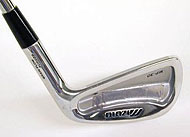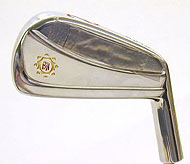What's the Deal With Lead Tape?
by Jeff Jackson, Mitchell Golf
Golfers are a fickle lot, always trying to come up with a way to shave a stroke or two from their score. Many will spend hundreds of dollars on new equipment, others will take lesson after lesson in the quest of a lower handicap. Still others will change grips or shafts in the quest of better performance. Some even swear by the application of lead tape as a means toward changing the flight of the ball. While there is no doubt that lessons or performance upgrades to equipment may help a player's game, the addition of lead tape to a club is much more fallacy than fact when it come to game improvement. Let's take a look at what adding lead tape does - or does not do - to influence ball flight.
If you take a look in to the bags of many tour pros and top amateurs and you will see lead tape on the back of their clubs. Depending upon whose bag you check out, you see tape in just about every conceivable location, from heel to toe and from top to sole. There is a good chance these players will tell you that the lead tape made it easier to draw or fade the ball or it allowed them to hit the ball just a bit lower or higher. If the player believes this, so be it. But in reality, the addition of the amount of lead tape that is usually put on a golf club has little, if any, effect on ball trajectory or direction.
Professional golfers have been using lead tape for decades to weight their clubs to obtain a specific feel. An amateur can do the very same thing. Any addition of weight will potentially alter the feel of the club. Golf club heads are designed to function at a certain weight. Each is cast or forged to that specific weight, give or take a few grams. To alter the actual performance of the head, a comparatively large weight change must occur. Lead tape does not provide enough weight to accomplish this. Lead tape is typically available in 1/2" wide strips. It takes 4 1/2" of this tape to add approximately 1 swingweight to the head. From a playability perspective, it makes absolutely no difference where the tape is placed. From a feel perspective, only the very best players in the world will be able to tell a 1 swingweight point change. Most players can, however, tell when a 3-point change is made. Keep in mind that it will take more than 13" of lead tape to raise the swingweight of a club 3 points. 13" is a lot of tape on the back of a golf club!
To test your own feel, tape a dime on the back of one of your middle or long irons and compare it to another mid or long iron. Are you honestly and consistently able to tell which one is heavier? The dime weighs approximately 2 grams, the same as adding 4 1⁄2" of tape. In effect you have increased the swingweight of the club about one point. Now try the same experiment with a quarter taped to the back of the club. The quarter weighs in at close to six grams or 3 swingweight points (13 1⁄2" of tape.) You will probably be able to tell which club is heavier now. What effect will this have on the actual playability of the club? Probably not much…but if the club feels better, you may be more comfortable with it and, as a result, make more consistent swings - and this can only help your scores.
Theories abound related to where to put the tape. Some believers in lead tape claim tape added to the heel of the club makes it close faster at impact creating straighter shots for the player who slices. The converse would be true by adding lead to the toe of the club for players who hook the ball. Even this positioning has been disputed for some time, but the sure thing is that adding a strip or two of lead tape will have virtually no effect on shot direction. Similarly, the idea of adding lead tape lower on the club to produce higher shots and adding it high on the club head to produce lower shots has been around for years. If a large amount of weight, say 15 grams or more could be redistributed somewhere on the clubhead, then, perhaps some playability differences could be found. But if this much weight were added, the swingweight of the club would become prohibitively heavy, actually compromising the club's playability. If some weight were removed by grinding or drilling somewhere on the head and then large amounts of tape added somewhere else, playability differences could certainly be noticed, but such changes actually alter the club's design and are not simply a result of applying lead tape to the club head.
While it can be uniformly agreed that the application of lead tape may cause a feel difference, there will be virtually no playability difference through the addition of reasonable amounts of tape. So is lead useless on golf clubs? Not necessarily. If a player is looking for a heavier club, lead tape will certainly make the club feel better to the player, thus producing seemingly better shots. As far as the tape actually moving the center of gravity, sweet spot, center of percussion, etc., any discernible difference just does not happen. The difference in feel is a direct function of the additional weight and not any center of gravity alterations.
A trend in face angle specifications among today's larger drivers is toward closed face angles. Why? A larger head is more difficult to return to a square impact position for potentially two reasons. One, the larger head has a center of gravity farther from the shaft. This causes the head to want to lag open due the load the head places on the shaft. A second consideration, especially with very large heads, is drag. The larger head occupies more space, thus making it more difficult to return to square as a result of air drag on the head. Closed face angles are a necessary design feature of larger heads that allows them to be returned to a square position at impact.
The pros' use of lead tape related to actual playability is to add weight to their clubs and nothing else. Some will tell you they can maneuver the ball better or hit it straighter as a result of the tape. If that is what they want to believe, then who is to argue with them? After all, what's wrong with a little psychological boost to a player's game? The simple fact is, despite what players or certain magazine articles may tell you, lead tape used in reasonable quantity, adds weight only and has little effect on playability. Try it yourself. Add some tape to the toe of your club; you will find that you do not all of a sudden fade the ball; if you add a strip of tape to the heel, it will not magically induce the draw you have been seeking. What it might do is change the feel of the club, making it seem heavier. This may be a good thing, especially if you prefer a heavier club; the added weight might even help to slow down a fast swing ever so slightly. If you are looking for a ball flight change, an equipment alteration or a series of lessons might work, but don't look to lead tape. The fact is, lead tape can add weight and change feel, but it won't change ball flight.
Professional golfers have been using lead tape for decades to weight their clubs to obtain a specific feel. An amateur can do the very same thing.
|


